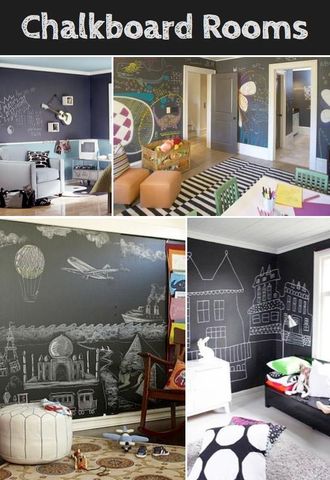Do’s and Don’ts of Chalkboard Paint to Make a Design Statement

Chalkboard paint is a huge trend—and why not? It creates a ready surface where you can jot down your shopping list or notes to family members, as well as a place where your kids (and even you!) can express your artistic urges whenever the mood strikes.
That said, there’s a method to applying chalkboard paint that homeowners would be wise to follow. Make sure to heed these do’s and don’ts, from what surface to paint to how long you should wait between coats to which kind of chalk to use once it’s good to go.
Do use it as an accent
When you’re looking at painting a large space such as your kitchen, chalkboard paint should be an accent, not the main attraction, says Dan Lightner, co-founder of the building and design firm Concrete Craft. Stick to one wall, like the space behind your kitchen table, to make things pop. But make sure you can access it easily. You’re going to want to write and draw on the paint, and if you have to move the table to do it every time, you’ll wish you’d picked another spot.
Perfectly placed accent wall
Houzz
———
Don’t limit yourself to walls
Chalkboard paint was designed for coloring on, but that isn’t all it can do.
“Use chalk paint on furniture and walls if you are trying to achieve an antique type look,” says Lightner. “You can also paint on glass, cabinets, clay pots, fences, and other accessories around the house to get that rustic look.”
To pull it off, use an aging technique. Apply a coat of chalkboard paint, let it dry until the paint is sticky, and wipe the coat down with a dry washcloth. The result will give you a faded look with lines and smears, which are perfectly rustic. To really sell the feel, use chalk. “Rub the chalk all over the entire surface to get a patina look,” Lightner says.
Yes, you can write on the furniture.
Houzz
———
Don’t stick to black
Many chalkboard paint designs you see are in black, but if a dark wall (or piece of furniture, décor item, or appliance) won’t look good in black, don’t force it. Chalkboard paint comes in a variety of colors and gloss levels. (We’re big fans of this vintage green seen below.) Go with what feels natural to the room and don’t forget to consider the lighting. If you have an already dark area, like a bathroom with few windows, you can sport black without a problem, but light-filled spaces will feel small and dark if painted black.
Broaden your color palette.
Houzz
———
Do prepare the surface carefully
Traditional paint is quite forgiving: It slides onto just about any surface and can even cover up small blemishes like cracks and nail holes. Not so with chalkboard paint, which is best applied to a flawless, smooth surface.
“Don’t paint over any holes or cracks in the wall; make sure you fill them before starting with your base coat,” Lightner says. And if the surface has a texture, scrape or sand before you paint.
Prep ahead to get a smooth finish.
Houzz
———
Don’t rush the paint job
Chalkboard paint is a bit different from what you’re used to. Most modern paint is designed to dry as quickly as possible, so you can apply multiple coats in a day and get on with your weekend; but slowing down is key with chalkboard paint.
Please, Mr. PostmanSend me news, tips, and promos from realtor.com® and Move.
Sign Up
You want to paint slowly and rhythmically to get an even surface (brushstrokes will show badly on walls).
“You want to work from the middle of your subject to the outside in a consistent manner and overlap your brush marks to get a level result,” Lightner says. Apply coats several hours or a day apart, and aim for at least three full coats overall.
When you’re done, don’t rush to start drawing on it, either. “Make sure you allow three days for the initial coats to dry before you apply the chalk on top of the paint,” Lightner says.
You’ll need a clear surface for writing.
Houzz
———
Don’t use the wrong kind of chalk
No, really, when it comes to chalkboard paint, there are wrong and right kinds of chalk.
“Don’t use extra hard chalk; use a soft chalk that will be easy to wipe off once applied,” Lightner says. Plus, “Don’t use chalk markers, use real chalk.” If you use the wrong kind, you’ll end up with smears on your paint that are nearly impossible to get off.
Trust us, ditch the markers.
Houzz
Do you have more chalkboard paint tips? We’re discussing on House Talk.
About the Business
Have a question? Ask the experts!
Send your question








